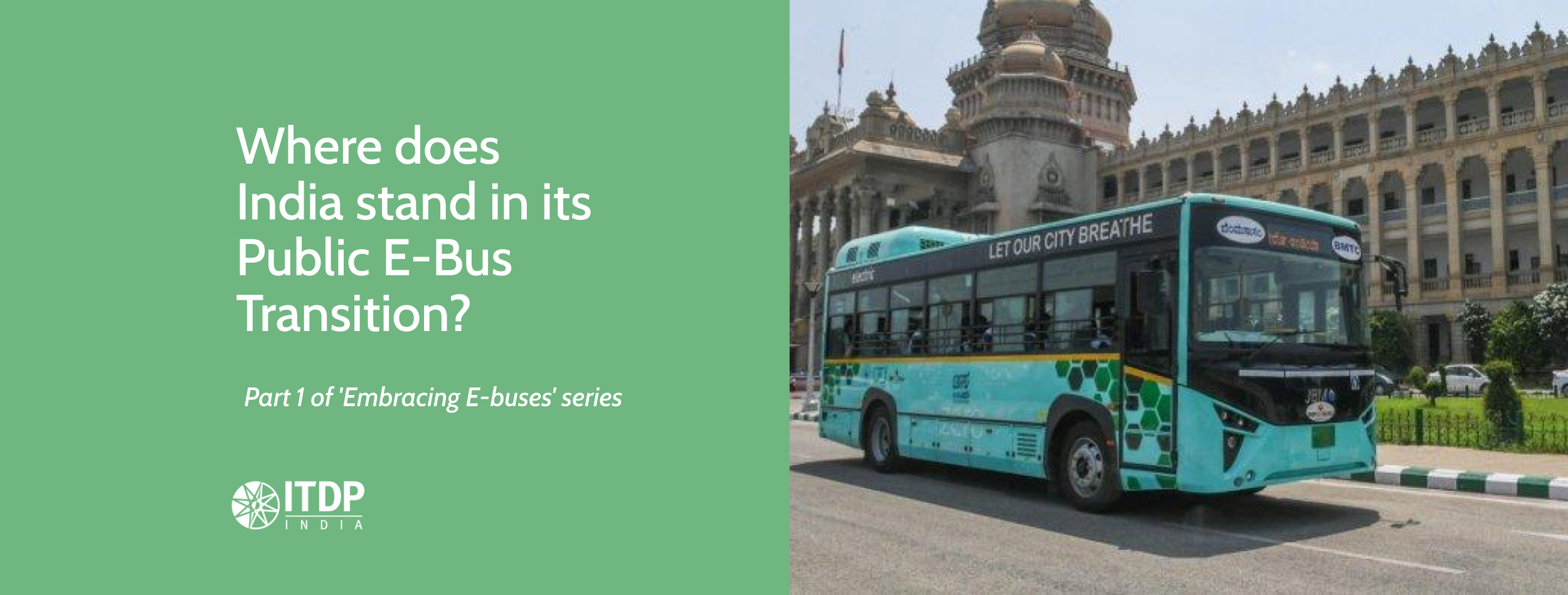
In India, the transport sector is responsible for 14% of overall greenhouse gas emissions. In light of the nation’s recent commitment to net-zero emissions by 2070, Indian cities have a unique opportunity to skip the usual stages of gradual and marginal improvements to public transport and fuel efficiency. What India needs is an urgent and ambitious vision to overhaul its public transport system. And e-buses may be the answer.
Cities need to improve and strengthen their transport systems and augment the number of buses on the streets. Buses can move people across cities more efficiently—in lesser space and at lower cost—and more affordably than any other transport mode. As of 2019, India had only ~30,000 buses to meet the needs of over 471 million people living in urban areas. As per the benchmarks laid out by the Ministry of Housing and Urban Affairs, cities require 60 buses per lakh population, and thus India needs an additional 1,45,000 buses to adequately serve the travel needs of citizens. India is operating at less than one-fifth of the buses that it needs.
Given the number of people who travel in every bus, the amount of tailpipe emission per passenger per trip is already low in even diesel and CNG buses. This can further be brought down to ZERO if we can accelerate the transition to electric buses. Here’s why e-buses are better.
Studies show that e-buses are more cost-efficient to operate compared to diesel/CNG buses, especially with rising fuel prices. In the case of Pune’s PMPML, the fuel cost/ km for 9m and 12m e-buses is ₹5.8 and ₹6.6 respectively, which is about one-third of Internal Combustion Engine (ICE) buses.
E-buses have a drastically lower environmental footprint as they require lower energy/km to operate. Compared to diesel buses, e-buses have zero tailpipe emissions. They also provide a much better service to passengers—smoke-free rides, smooth rides. As per an April ’22 survey conducted by PMPML in association with ITDP India among e-bus commuters, 78% of respondents prefer to travel by e-bus because of less noise and vibrations.
With fewer moving parts, e-buses require lesser maintenance, reducing the maintenance cost and the overall financial cost of operating them. They are also more reliable and have a lower trip cancellation rate, improving the quality of service. The benefits are umpteen, so it is advisable for urban bus operators to transition to e-buses.
Since 2015, India has seen multiple schemes to promote the transition to e-buses, by subsidising the cost of their purchase for cities. However, the road to transition is replete with its own set of challenges. Most city & state transport undertakings (STUs)—the agencies responsible for public bus operations in India lack the technical knowledge to procure, deploy, and manage e-bus fleets optimally. Several STUs also face funding gaps and do not have budgets to make direct purchases, leading to slow uptake of these schemes.
In this blog, we investigate the current status of e-buses in India, and how close (or far?) we are to a 100% transition.
To accelerate the transition to electric and hybrid vehicles—such as 2-wheelers, cars, 3-wheelers, and buses—the Department of Heavy Industries (DHI) launched the Faster Adoption and Manufacturing of Electric Vehicles (FAME) Scheme in 2015 under the National Electric Mobility Mission. FAME was a subsidy programme for electric vehicle manufacturers as well as providers. Under the scheme, the State Transport Undertakings (STUs) were given subsidies to procure public electric buses and install the required charging infrastructure. FAME-I offered two options for STUs—Outright purchase and Gross Cost Contract, with subsidies from the Government of India. For the purchase of e-buses, which typically cost between 75 lakhs (USD 93670) to 1.75 crores (USD 218500) depending on the battery size, DHI offered two kinds of demand incentives:

Five cities (Bangalore, Mumbai, Hyderabad, Ahmedabad, and Jaipur) invited bids under GCC, and the rest (Indore, Lucknow, Kolkata, Jammu and Guwahati) went ahead with the outright purchase of buses. However, the rollout of buses has been slow in many states due to a variety of reasons. Tenders have been cancelled in Bangalore, Mumbai, Ahmedabad, and Jaipur—all cities that chose to go ahead with GCC except Hyderabad—while buses have been pressed into service in the rest.
Under the GCC model, the tender conditions, bus requirements, and range requirements were vastly different across cities, leading to a considerable variation in prices. Cities requested for 9m/12m buses, AC and non-AC variants. Another notable difference was in terms of the city’s range requirements (assured km per day). Kolkata, for example, had one of the lowest requirements at 150km/day while Hyderabad asked for 225 km/day. The tender documents also revealed that some cities pushed the cost of electricity onto the GCC operators, while others chose to pay for it themselves. This also led to a lot of tenders getting cancelled.
By the end of the FAME-I scheme, 10 cities received the subsidy, and a total of 425 e-buses were deployed:
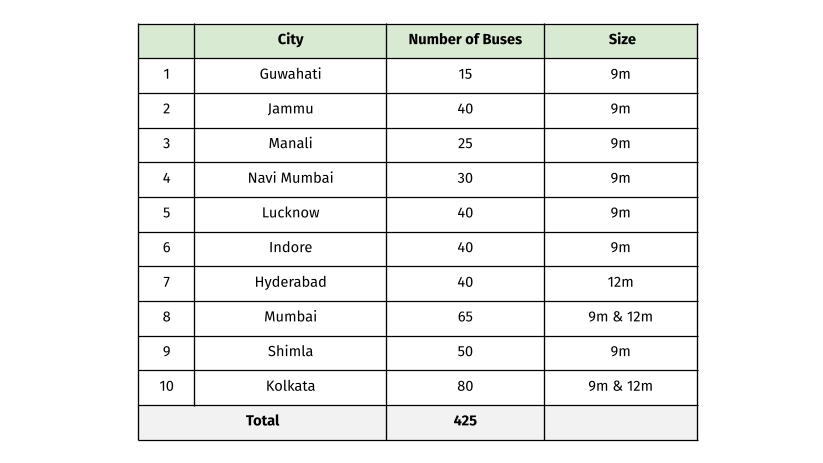
The steep costs of electric buses were worrying—compared to diesel buses, electric buses were 2-3 times more expensive, and hence many transport undertakings were not in favour of deploying the new technology, especially through direct purchase.
In 2019, the Government of India approved Phase II of the FAME Scheme, with total budgetary support of INR 10,000 Crore (USD 1.3 billion). FAME-II focussed on the electrification of public & shared transport. Through this scheme, DHI intended to support the procurement of 7090 e-buses, with a total outlay of about INR 3500 Crores (USD 450 million). For a city to be selected, it needed to meet two criteria—one was that the state had an Electric Vehicle policy; and two, it had a provision to waive the registration charges and road taxes for electric vehicles. FAME-II also mandated procuring buses through a ‘Gross Cost Contract’ (GCC). Under FAME-II, DHI offers a maximum demand incentive of INR 55 lakhs (USD 71k) per bus for 10-12m buses, INR 45 Lakhs (USD 58k) for 8-10m buses, and INR 35 Lakhs (USD 45k) for 6-8m buses. FAME-II received a tremendous response—86 proposals from 26 States and Union Territories for the deployment of 14,988 e-buses. After a thorough evaluation, the Government of India sanctioned 64 City & State Transport Undertakings to procure 5095 e-buses for intra-city operations; 400 e-buses for inter-city operations; and 100 e-buses for last-mile connectivity to Delhi Metro Rail Corporation (DMRC). DHI approved the highest number of e-buses for the state of Maharashtra (725 e-buses), followed by Uttar Pradesh (600 e-buses), Gujarat (550 e-buses) and Tamil Nadu (525 e-buses), while other states received a sanction of less than 500 e-buses.

As of Dec’ 2021, 2965 buses have either been deployed/received a supply order or received extension to issue a supply order, as part of the FAME-II scheme.
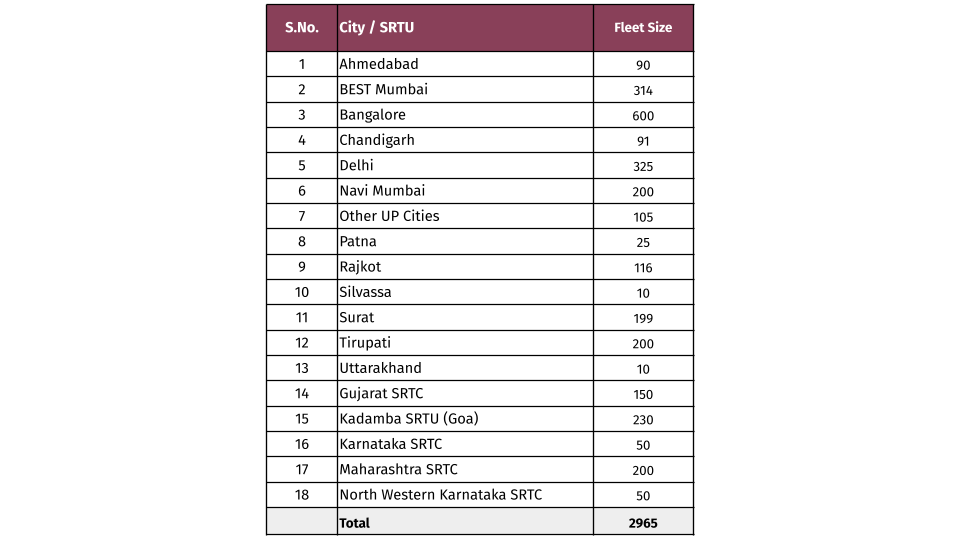
A lot of cities were not able to utilise FAME-II assistance, as many e-bus suppliers quoted significantly higher prices during the FAME-I scheme, owing to higher liabilities such as setting up of charging infrastructure. The COVID-19 pandemic also impacted many cities’ plans to procure e-buses under the scheme. Tenders were cancelled in several cities.
To bring down the per km price, Convergence Energy Services Ltd (CESL)—an arm of the state-owned Energy Efficiency Services Ltd.—was tasked to aggregate the demand and float a combined tender on behalf of all 9 remaining cities with more than 4 million population, on the GCC model. The STUs were invited to express their interest to aggregate the demand. As a result, CESL rolled out a tender for 5,450 buses worth INR 5,500 crores (USD 706 million), seeking bids for e-bus operations in five cities: Kolkata, Delhi, Bangalore, Hyderabad, and Surat. Tata Motors has emerged as the lowest bidder across all five operational categories. Because of the mass tender, the bid received were less than ₹50/km for 12m buses.
Outside FAME-I and II, many state and city governments have shown interest in procuring electric buses, with a majority opting to procure e-buses under the GCC model.
Pune’s public bus operator, Pune Mahanagar Parivahan Mahamandal Ltd., procured 25 9m variant e-buses and 125 12m variant e-buses, with funding from the Smart Cities Mission of the Ministry of Housing and Urban Affairs. As this procurement was done outside the FAME schemes, the Municipal Corporations of Pune and Pimpri Chinchwad decided to provide an upfront subsidy of INR 50 lakhs/bus (USD 65,000) through the Smart City Funds.
Other states have also issued Request for Proposals (RFPs) for e-buses, with fleet sizes ranging from 10 to 500. Delhi is the largest of them all. DIMTS, the Special Purpose Vehicle that manages the city’s cluster bus operations, has already initiated the process to procure 375 12m variant AC e-buses.
In 2019, the Government of Tamil Nadu received a loan of INR 1,600 crore (USD 200 million) from KfW, the German state-owned development bank, to procure 2,000 e-buses, of which 500 would be procured under outright purchase by 2022 in Phase-I.
To meet its current public transport needs, Indian cities need 1,75,000 buses, while presently they have only 35,000 buses operated by STUs. Of these, around 2000 are electric. The gap is wide, but not insurmountable.
Funding under the FAME schemes and from other sources have accelerated the procurement of e-buses and the adoption of the Gross Cost Contract model in Indian cities. Going forward, cities require similar sustained financial support to enable a 100% transition to e-buses.
The procurement of e-buses is only the beginning, and states need to identify sustainable funding sources to keep e-bus operations up and running. States and cities should consider setting up Urban Transport Funds (UTF), which will not only help sustain the operations of e-buses but also help cities maintain high-quality service. Tamil Nadu, for example, has used loans from development banks to improve and expand their bus operations, and other STUs must also consider such methods of financing.
Most STUs currently lack the knowledge to plan and operate e-buses. As cities procure more and more e-buses, it’s essential that public transport operators now equip themselves technically to deploy and utilise upcoming e-bus fleets efficiently and effectively. As Indian cities embark on this transition, a capacity development programme and peer-to-peer learning for city officials across the country would go a long way towards ensuring cities have all the support they need to make our transition to 100% e-buses in Indian cities.
Stay tuned to the next part of the series where we see how cities can choose among the different types of procurement models in India, for a faster and smoother transition to e-buses.
Written by: Aishwarya Soni
Edited by: Keshav Suryanarayanan
With inputs from: Vaishali Singh and Dhruv Soni
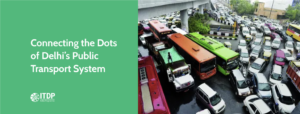
Find how the intricate network of Delhi’s public transport system and its ongoing efforts enhance connectivity, improve accessibility, and provide a seamless travel experience for millions of commuters in the bustling metropolis.”
Pune, Coimbatore, and Chennai emerge as India’s Smart Cities, paving the way for sustainable urban development and innovative solutions. Explore their strategies and initiatives towards building smart and livable cities for the future.

Join us on a journey with inspiring women who are cycling for change. Discover their stories of empowerment, resilience, and how they are transforming cities by advocating for cycling as a sustainable mode of transport.
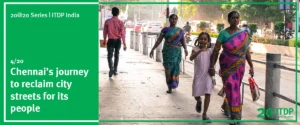
Chennai’s remarkable journey towards reclaiming city streets for its people. Uncover the inspiring initiatives and transformative efforts that are reshaping the urban landscape and prioritizing people-centered mobility.
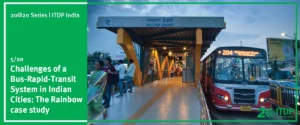
Learn from the Rainbow case study to understand the key considerations and solutions for building efficient and sustainable urban transportation systems.
